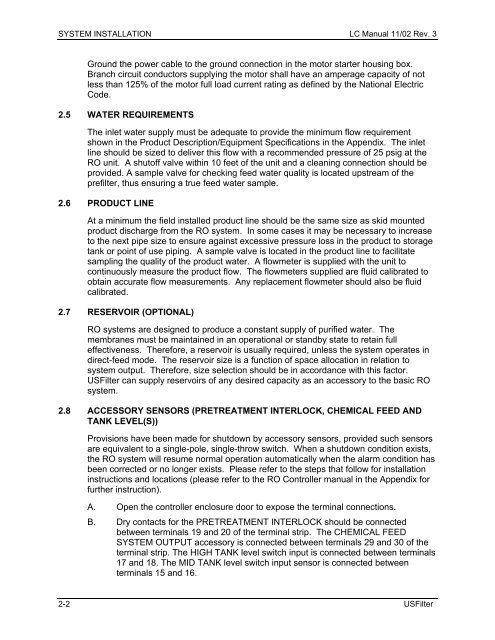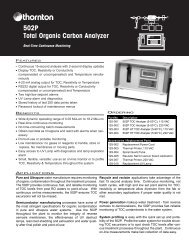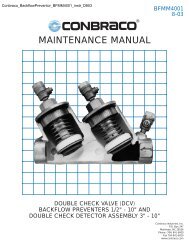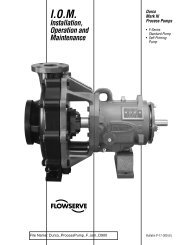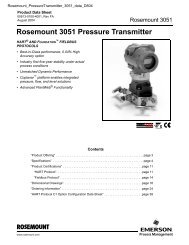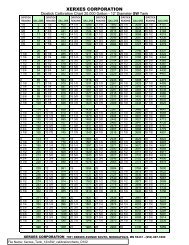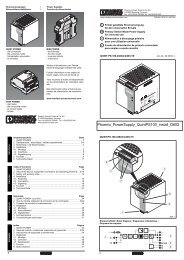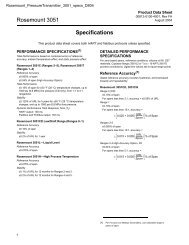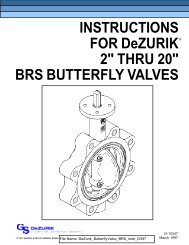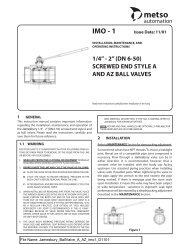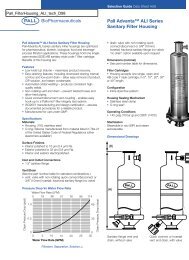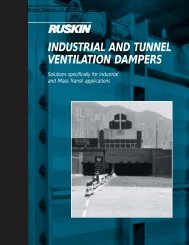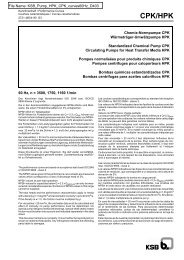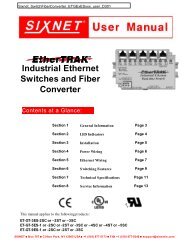Operation and Maintenance Manual for
Operation and Maintenance Manual for
Operation and Maintenance Manual for
Create successful ePaper yourself
Turn your PDF publications into a flip-book with our unique Google optimized e-Paper software.
SYSTEM INSTALLATION LC <strong>Manual</strong> 11/02 Rev. 3<br />
Ground the power cable to the ground connection in the motor starter housing box.<br />
Branch circuit conductors supplying the motor shall have an amperage capacity of not<br />
less than 125% of the motor full load current rating as defined by the National Electric<br />
Code.<br />
2.5 WATER REQUIREMENTS<br />
The inlet water supply must be adequate to provide the minimum flow requirement<br />
shown in the Product Description/Equipment Specifications in the Appendix. The inlet<br />
line should be sized to deliver this flow with a recommended pressure of 25 psig at the<br />
RO unit. A shutoff valve within 10 feet of the unit <strong>and</strong> a cleaning connection should be<br />
provided. A sample valve <strong>for</strong> checking feed water quality is located upstream of the<br />
prefilter, thus ensuring a true feed water sample.<br />
2.6 PRODUCT LINE<br />
At a minimum the field installed product line should be the same size as skid mounted<br />
product discharge from the RO system. In some cases it may be necessary to increase<br />
to the next pipe size to ensure against excessive pressure loss in the product to storage<br />
tank or point of use piping. A sample valve is located in the product line to facilitate<br />
sampling the quality of the product water. A flowmeter is supplied with the unit to<br />
continuously measure the product flow. The flowmeters supplied are fluid calibrated to<br />
obtain accurate flow measurements. Any replacement flowmeter should also be fluid<br />
calibrated.<br />
2.7 RESERVOIR (OPTIONAL)<br />
RO systems are designed to produce a constant supply of purified water. The<br />
membranes must be maintained in an operational or st<strong>and</strong>by state to retain full<br />
effectiveness. There<strong>for</strong>e, a reservoir is usually required, unless the system operates in<br />
direct-feed mode. The reservoir size is a function of space allocation in relation to<br />
system output. There<strong>for</strong>e, size selection should be in accordance with this factor.<br />
USFilter can supply reservoirs of any desired capacity as an accessory to the basic RO<br />
system.<br />
2.8 ACCESSORY SENSORS (PRETREATMENT INTERLOCK, CHEMICAL FEED AND<br />
TANK LEVEL(S))<br />
Provisions have been made <strong>for</strong> shutdown by accessory sensors, provided such sensors<br />
are equivalent to a single-pole, single-throw switch. When a shutdown condition exists,<br />
the RO system will resume normal operation automatically when the alarm condition has<br />
been corrected or no longer exists. Please refer to the steps that follow <strong>for</strong> installation<br />
instructions <strong>and</strong> locations (please refer to the RO Controller manual in the Appendix <strong>for</strong><br />
further instruction).<br />
A. Open the controller enclosure door to expose the terminal connections.<br />
B. Dry contacts <strong>for</strong> the PRETREATMENT INTERLOCK should be connected<br />
between terminals 19 <strong>and</strong> 20 of the terminal strip. The CHEMICAL FEED<br />
SYSTEM OUTPUT accessory is connected between terminals 29 <strong>and</strong> 30 of the<br />
terminal strip. The HIGH TANK level switch input is connected between terminals<br />
17 <strong>and</strong> 18. The MID TANK level switch input sensor is connected between<br />
terminals 15 <strong>and</strong> 16.<br />
2-2 USFilter


